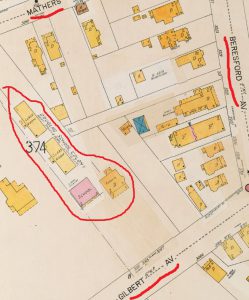 The Board of Education created a model school for the Walnut Hills African American community in 1911. (See our article on that building.) A few years later, the “Great Migration” of African Americans from the rural South to the urban North began in earnest. A 1925 planning report noted that Frederick Douglass School, located at Chapel Street and Alms Place, required increased classrooms for 400 more students beyond the current capacity of 980, and that it required an additional 2 acres of playground. A description of Walnut Hills published in 1943 noted “The rapid increase in Walnut Hills’ Negro population following the [First] World War called for another expansion of capacity at the Douglass School. The colored people, however, were spreading largely to the west and north beyond Gilbert Avenue. For the convenience of the more distant pupils, an addition to the Douglass School was placed near the new colored neighborhood. Established at its present site on Gilbert Avenue, this subsidiary branch of the Douglass School is called the Douglass Colony School.”
The Board of Education created a model school for the Walnut Hills African American community in 1911. (See our article on that building.) A few years later, the “Great Migration” of African Americans from the rural South to the urban North began in earnest. A 1925 planning report noted that Frederick Douglass School, located at Chapel Street and Alms Place, required increased classrooms for 400 more students beyond the current capacity of 980, and that it required an additional 2 acres of playground. A description of Walnut Hills published in 1943 noted “The rapid increase in Walnut Hills’ Negro population following the [First] World War called for another expansion of capacity at the Douglass School. The colored people, however, were spreading largely to the west and north beyond Gilbert Avenue. For the convenience of the more distant pupils, an addition to the Douglass School was placed near the new colored neighborhood. Established at its present site on Gilbert Avenue, this subsidiary branch of the Douglass School is called the Douglass Colony School.”
The Frederick Douglass Colony School, opened in 1927, did save the young children from the hazard of crossing Gilbert Avenue. That might have been its only virtue as an educational facility. The Colony start out as simply a red brick house converted for school use, on a long lot between Gilbert Avenue and Mathers, just one block from the Kerper Apartments and two from the Washington Terrace Apartment complex. Those last developments overseen by Jacob Schmidlapp in the 1910’s provided housing for nearly 200 African American families. The Colony School rapidly grew to include another existing building, and then two or three temporary frame classroom annexes.
The School Board’s reaction to overcrowding in the African American school in the late 1920’s – still a period of great prosperity in Cincinnati – proved very different from that in 1910. The Colony did not include any showers, as had Douglass in 1910. One student remembers attending the school when she lived with her family in a cold-water apartment on Gilbert Avenue; the need for schoolhouse bathing had not evaporated. It is not clear whether the yard included any playground improvements; a resolution of the city council in 1934 leased the space to the Park Board for an intended playground. A report on the Cincinnati Public Schools commissioned in 1935 asserted “Gilbert Avenue School (Douglass Annex) is probably the most poorly housed school in the city. It should be abandoned at the first possible moment and the pupils transferred to the Douglass School.”
The Colony School continued in its poorly housed state for more than another decade. Yet despite the inadequate facility, the Douglass Colony provided a strong Afrocentric institution for its students, rooted in the Black Walnut Hills community. As at the main Frederick Douglass School, all the teachers were Black. Martha Hall Ross, head teacher from 1933, had herself graduated from Walnut Hills High School in 1901 or 1902, and from the University of Cincinnati in 1906. She served in offices in the Ohio Federation of Colored Women’s Clubs and was a member of the Fidelia Club, one of the original Cincinnati Federation Clubs. She also worked in the Negro Civic Welfare Committee of the Community Chest, and lived on Buena Vista, within a few blocks of both the Colony School and Washington Terrace.